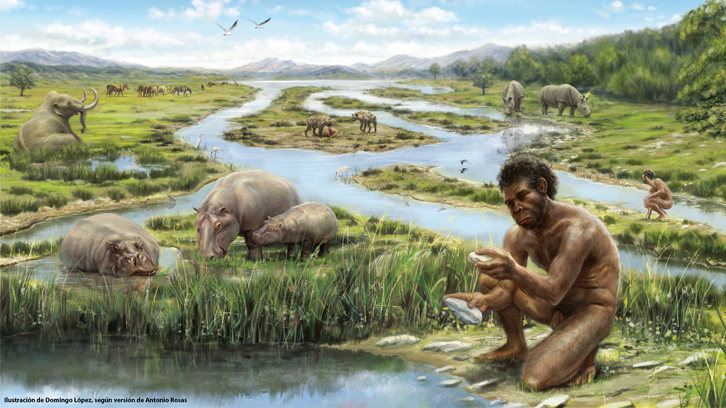Reconstructing Quaternary European Ecosystems from Hippo Fossils

Recently published research centered on the fossil hippopotamus populations from Europe highlighted the importance of the dispersion and ecological requirements of these forms in relation with fossil hominin dispersals into Europe. The authors studied fossil unpublished remains of hippos from the Barranc de la Boella site (Francolí Valley, Tarragona) to understand the ecosystems habited by both these forms and hominids.
The Quaternary, a geological period that began about three million years ago, is one of the most important epochs in human evolution for understanding the first dispersals of hominids from Africa into Eurasia. Surprisingly, this geological period was characterized by strong climatic fluctuations prompted by the new glacial dynamics. In this sense, and during the Quaternary, the European ecosystems changed from sub-tropical environments to the nowadays climatology.
To understand all these former climatic changes, scientific disciplines like paleontology study fossil remains from paleontological sites to make inferences about the evolution of mammal species, as well as in vegetal and animal ecosystems as a whole. Specifically, the study of fossils of animals like hippos can provide valuable information on one of the most important resources for life, fresh water.
In new research recently carried out by researchers of the Museo Nacional de Ciencias Naturales (CSIC), the Universitat Autònoma de Barcelona and the Institut Català de Paleoecologia Humana i Evolució Social, inferences on past ecosystems were made based on unpublished fossil hippo remains from the Barranc de la Boella site.
The former paper reinforces the idea of the first dispersal of hippos populations of the species Hippopotamus antiquus outside Africa into European favorable ecosystems close to two million years ago. These fossils formed unearthed from Turkey to the British Islands and inhabited Europe until 400.000 years ago when another dispersal of the extant common hippo (Hippopotamus amphibius) from Africa replaced the existing species. The living form vanished from Europe around 40.000 years ago inhabiting Europe during several interglacial ages.
Additionally, the current research based on the fossil mammoths, sabertoothed cats or monkeys from the Barranc de la Boella site is providing interesting information on the ecosystem’s dynamics in Europe in a crucial period of human evolution. Specifically, around 1 million years ago and first recorded at la Boella, the hominids exhibit a new and sophisticated new technological lithic tool that could help them to subsist in unfavorable conditions.
(1) Area of Paleontology, Department of Geology, Universitat Autònoma de Barcelona
(2) Departament of Paleobiology, Museo Nacional de Ciencias Naturales (CSIC)
References
Fidalgo, D., Rosas, A., Madurell-Malapeira, J., Pineda, A., Huguet, R., García-Tabernero, A., Cáceres, I., Ollé, A., Vallverdú, J. and Saladie, P., 2023. A review on the Pleistocene occurrences and palaeobiology of Hippopotamus antiquus based on the record from the Barranc de la Boella Section (Francolí Basin, NE Iberia). Quaternary Science Reviews, 307, p.108034. https://doi.org/10.1016/j.quascirev.2023.108034


